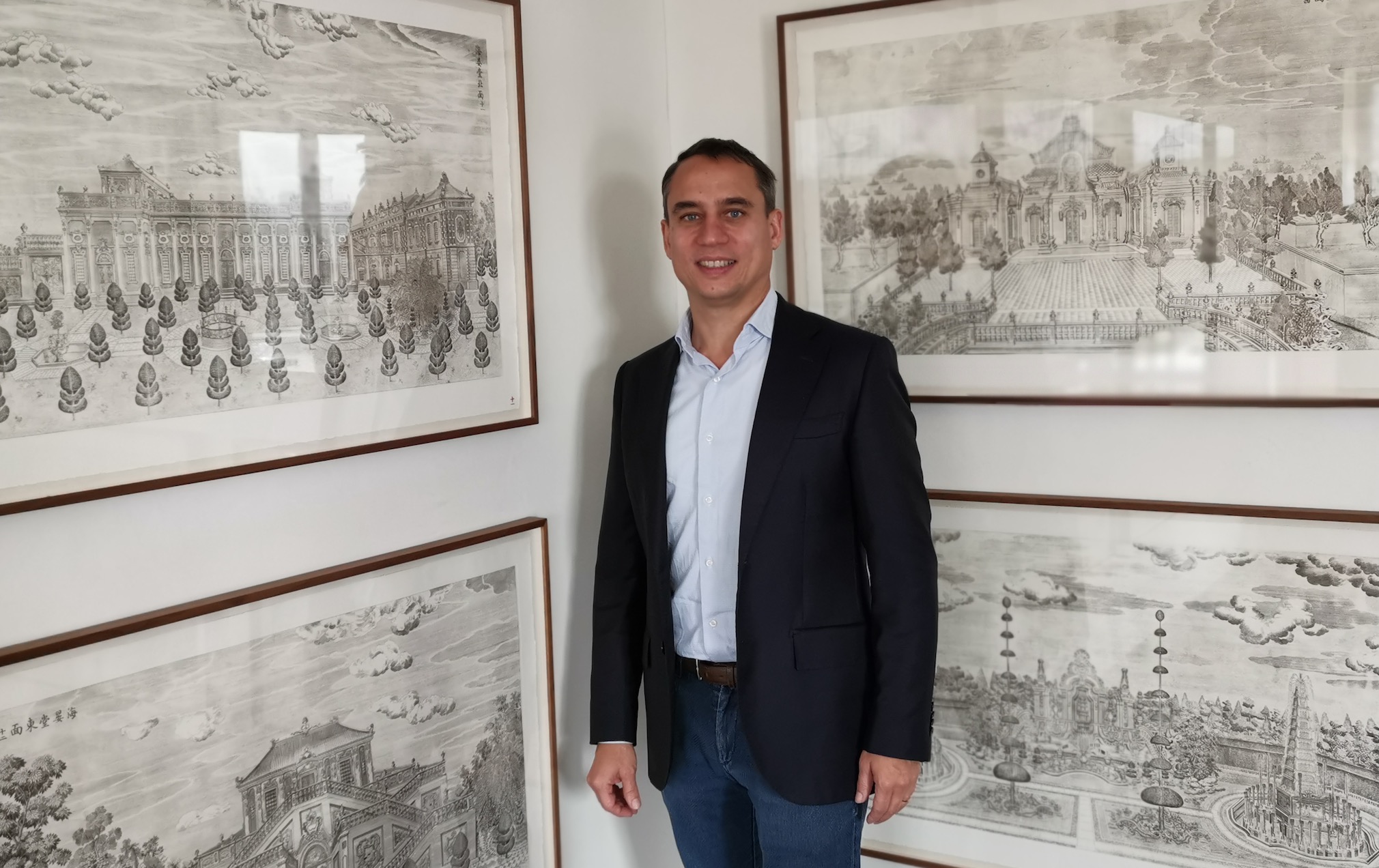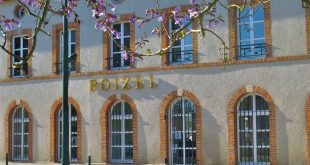

Situated in the Qiu Shan Valley in Penglai, Shandong, Domaine de Long Dai has become the most talked about winery and wine in China.

The buildings, winery, cellar, offices, visitor centre, dining hall and accommodation were built after the vineyard was first planted in 2011.
Lesser mortals would be deterred by the herculean challenges but not the single-minded people at DBR or Domaines Barons de Rothschild, the same who own Pauillac First Growth Chateau Lafite. Their sense of purpose and mission is as incorrigible as the landscape is rugged.
There are a staggering 360 terraces that make up the 30 hectares of widely distributed vines at Domaine de Long Dai. The plantings are 58% cabernet sauvignon, 15% merlot, 15% marselan, 12% cabernet franc and a few plots of syrah (which is very sensitive to rain). In 2019, petit verdot was also planted.
It would had been tempting to reduce the formidable number of terraces by flattening out some of the geography. The hardy souls at Domaine de Long Dai decided instead to preserve the landscape and the soil structure. It seems they worship nature as much as they love wine.
In the process, they happily assume the extra manual, physical and mental exertion required to keep a far-reaching tab of each and every undulating, individual terrace.
When the land was first purchased 10 years ago, everything had to be started from scratch. Quite the best way to begin an adventure. As a result, very challenge overcomed became a lesson learnt for posterity. And in the best French tradition of trying to understand the terroir – where best to plant the different grape varieties – more than 400 pits were dug into the ground in the effort to understand the different soils.
What the eye sees may not be what it seems. Just because a terrace is near another does not mean their soil profile is identical or even similar. As such, the terraces are zoned according to grape potential rather than location. To further ensure the optimal level of ripeness, each terrace is harvested in several passes. No rest for the “wicked”. After all, if you had come all the way from Pauillac to Qiu Shan Valley – a distance of more than 9,000 kilometres – why would you then take short cuts?

Juliette Couderc – who joined in September 2017 – is Technical Manager in charge of the winery and vineyards.

LIANG Chen joined in June 2014 as Winemaker.

General Manager Charles Treutenaere is fluent in Chinese and has lived in China for many years.

The circular cellar is reminiscent of Pauillac First Growth Chateau Lafite-Rothschild in Bordeaux. The red columns is a nice Chinese touch.

The Four Seasons of Lafite in photographs reminds visitors of the link Domaine de Long Dai has to Bordeaux.
You may also want to read … Domaine de Long Dai 2017
Qiu Shan Valley
Qiu Shan Valley is 16 kilometres south of Yantai Airport, and about 220 km north-east of Qingdao, the biggest city of Shandong Province. The Yellow Sea is only 20 km away. When I visited on 28 October 2019, the apple harvest was in full swing. The most popular variety is Fuji. First introduced in the late 1980s, farmers adore the pink Japanese blush because, being popular, it fetches a higher price than traditional varieties. Farmers also tend to prefer growing apples to table grapes because the bigger fruit is more hardy, less susceptible to variations in weather and, therefore, require lower maintenance.
Spring is dry in Qiu Shan. Summer is warm but with a monsoon season at the end of July and the beginning of August. Unlike in the tropics, the rainy season in there sees two or three episodes of huge but short rainfall where, in an hour or two, up to 100 mm of rain can be furiously decanted from the sky. Fortunately, there was no monsoon in 2018 and 2019. When the rains don’t come, the dry, hot weather is very conducive for ripening. Also, the soil being predominantly sandy water just passes through. There is, however, the risk of rot and mildew. Domaine de Long Dai has no plan to make a white wine because of the ever-present phenomenon of monsoon. And also because the Rothschilds are red wine specialist. Winter is dry and cold but not as freezing as in Xinjiang, Ningxia, Hebei, and Shaanxi where you have to bury the vines.

The 360 terraces of the 30 hectares are planted to cabernet sauvignon, marselan, cabernet franc and a few plots of syrah. In 2019, petit verdot was also planted. This photograph is of marselan. The first vines were planted in 2011.

The soil is sandy and granitic. The pink granite reminds Technical Manager Juliette Couderc of something similar in Brittany, parts of the Loire, and Saint-Chinian in the Languedoc.
Not Very Interested
‘The (Rothschild) family are not very interested in that kind of viticulture. They wanted a continental climate but not too continental. Here in Penglai, you can ripen cabernet sauvignon, merlot and marselan. That’s why they chose this region.’
‘At the same time, 10 kilometres away you can find vines that are too vigorous. We were looking for a valley to have a vineyard with superficial or poor soil,’ explained General Manager Charles Treutenaere.
Another French expatriate is Juliette Couderc, who joined Domaine de Long Dai in September 2017 as viticulturist. She is now Technical Manager in charge of the winery and the vineyard.
‘The first vines were planted in 2011. The cuttings were from a Chinese nursery. But the clone was not good and, sometimes, even the stated variety was not what it turned out to be.
‘Starting in 2013, we started importing cuttings from a famous French nursery in the Rhone. In China, there is a 40-day quarantine for imported vines.’
Although Couderc does not think there is a risk of phylloxera, what were originally planted and imported are resistant to the louse because “there are also other considerations in the root stocks we choose such as managing the vigour of the vine”.
The soil at the domaine is sandy and granitic. The pink granite reminds Couderc of something similar in Brittany, parts of the Loire, and Saint-Chinian in the Languedoc.
Although it is permitted in China to irrigate, this is not the practice at Domaine de Long Dai.
Fermentation is in stainless steel tanks ranging from 15 to 90 hectolitres. That versatility allows for fermenting different vineyard plots separately. The tanks are produced in Shanghai by French construction giant Actenium.

Fermentation is in stainless-steel tanks.

The Great Hall

Interior of The Great Hall

Dining Room
When to Harvest
The decision when to harvest at Domaine de Long Dai is made by the local team in China. Harvesting is by hand in small crates. The grapes are destemmed and placed on a sorting table where the berries are sorted individually. After this micro selection, they are crushed and go into the tanks to begin the alcoholic fermentation. A gentle pump-over ensures a gentle extraction of the tannins. The maceration period is between 18 and 21 days.
Although 2017 represents the first vintage of Domaine de Long Dai, wines were made in 2014, 2015 and 2016. They were, however, not considered good enough to be released commercially.
From the very start, the domaine was conscious of its link with the local community. The vineyard was set up in collaboration with the farmers of Mulangou, the nearby village. Their contribution has been described as “precious” to complete the knowhow of the DBR team. Ten of these farmers have joined the domaine on a permanent basis and – when required – other villagers have also been recruited when seasonal help is called for.
The winery, cellar, offices, dining hall, visitor centre, and accommodation that now represent Domaine de Long Dai did not exist two years ago. The vineyard came before.
The Rothschild family are first and foremost winegrowers. This is the responsibility and mantra they proudly pin over their shoulder. They put the horse before the cart. Not the other way around. That’s how you begin a journey of discovery.

Visitor Centre where you can purchase Domaine de Long Dai and wines of the Domaines Barons de Rothschild (Lafite).

Although wine was produced in 2014, 2015 and 2016, they were not considered good enough. The first commercial release is 2017.

There is a microchip under the capsule to confirm that the bottle is authentic


